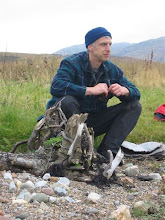
You might know from gardening that some flowering plants do better some years than others. Well the same can work for wildflowers and this year is the year of the cuckooflower. It has been bursting forth in pink waves on damp grassland across the area this year in exceptional amounts including all around the edge of Flanders Moss. It is named from the fact that it usually comes into flower when the cuckoo arrives, around about the end of April but continues to flower through into June. It is a plant of many names and two that I know are lady's smock and milkmaids. I don't know why these wildflowers fluctuating years of abundance but it is likely to include the effect of previous springs and winters that has the collective effect of promoting vigorous flowers from plants that otherwise may lie dormant. In recent years with warmer springs it has started flowering earlier still and this might causes problems for one of the creatures that uses it for food. The orange tip butterfly lays its eggs on cuckooflowers so that the caterpillars can feed on the plant when they hatch. The eggs are laid just under the flowers and when the caterpillars hatch they feed on the developing seed pods that are packed full of energy. But all this needs careful timing so that there is enough food for the caterpillars to fill up on, too early and there are no seed pods to eat, too late and the plant is dying back just when the caterpillars want the most amount of food. This is just one illustration of how climate change is affecting the everyday wildlife we see. Climate change can have unforeseen knock-on effects as cuckooflower is reputed to be sacred to fairies. As the flower was so special to them traditionally is was never picked for bunches of flowers in case you angered them. So just think when you next take the car rather than walk a short journey that the effects can be even wider ranging you might have imagined.


